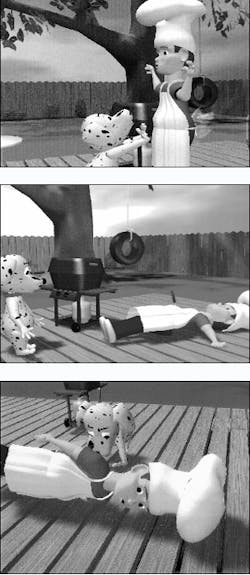No doubt you have seen the marvels of computer animation but may not have matched the jargon with the effects just yet. If you have watched the TV commercials featuring dancing and skating polar bears celebrating a soft drink, frogs sitting in a pond declaring their loyalty to a brand of beer, or dancing cars and gas pumps that proclaim their happiness with a particular gasoline, or if you have seen the movie, “Toy Story,” you have witnessed the marvels of computer animation.
To attract a wider audience for its fire safety messages and public education programs, Livonia Fire & Rescue in Michigan became one of the first fire departments in the country to use computer animation.
As computers have become more powerful in recent years, computer animation has gained certain advantages over traditional “cel” animation, in which animators drew each frame, or cel, to be filmed in sequence. Production time and costs for quality animation can both be decreased through computer animation over traditional animation, which requires the talents of animators (drawing out every few cels), “in betweeners” (you guessed it, they draw the cels in between the animator’s drawings) and inkers, who add the colors and backgrounds.
The computer has eliminated the need for the painting and filming of each cel by recording each frame of animation digitally onto a computer hard drive, which can then be transferred to video or film. What once took a team of artists many hours can now be accomplished by a single person at a desktop computer with the proper equipment.
Livonia Fire & Rescue teamed up with Creative Vision Animation to create a high-tech public service announcement (PSA) to be used as a stand-alone piece or to illustrate a point graphically for the audience in a more general fire safety presentation. Like numerous fire departments, the department faces the problem of trying to create new and exciting ways to deliver the message of fire safety. Local cable TV channels have numerous PSAs on file, usually involving spoken interviews, simple graphics and fire file footage. Computer animation lets the fire department show exactly what it wants without worrying about fire dangers to human “actors” or problems in operations with live fire footage.
As a public service, Creative Vision Animation agreed to provide Livonia Fire & Rescue with a 45-second computer animation PSA involving a scene where subjects learn first-hand the importance of remembering to “Stop, Drop and Roll” when clothing catches fire. To produce a full-length, completely computer-animated video would be cost prohibitive but the process can be used effectively in PSAs for local cable TV use as a stand-alone piece as well as part of a larger program to illustrate that one point. This lets the fire department teach similar lessons but to wrap them differently so the audience doesn’t get bored seeing the same message in the same style.
The subject of the PSA produced for Livonia Fire & Rescue is a man cooking on a backyard grill who gets a little too close to the barbecue. As he notices his clothing is on fire, the “voice-over” announcer interjects the correct behaviors, which the subject is able to do with the help of his friendly dog.
The computer animation PSA has been enthusiastically received by the fire department’s members as well as cable TV companies and the customers we serve. The department is looking for more uses for computer animation in its continuing efforts to fully utilize current technology to assist in delivering its important safety messages.
To inquire about computer animation for your department’s needs, check local telephone listings under “animation,” consult with local producers groups through a local cable TV provider or contact Creative Vision Animation at 26913 Southwestern, Redford, MI 48239.
Tom Kiurski is director of fire safety education for Livonia, MI, Fire & Rescue. He has an associate’s degree in fire science, a bachelor’s degree in fire and safety engineering technology, and a master’s degree in public administration.





